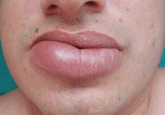Article
Diagnostic puzzler: Acute eyelid edema
- Author:
- Omar Rayward, MD, PhD
- Jose Luis Vallejo-Garcia, MD
- Paula Moreno-Martin, MD
- Sergio Vano-Galvan, MD, PhD
The patient’s eyelid was not inflamed or painful, but it was swollen enough to impair his vision. What’s your diagnosis?
Article

A persistently swollen lip
- Author:
- Sergio Vañó-Galván, MD
- Paula Moreno-Martin, MD
- José-María Arrazola, MD
- Pedro Jaén, PhD
An otherwise healthy man has had asymptomatic swelling of his lower lip for 10 months. What is the cause? What is the treatment?
Article
Generalized pruritus after a beach vacation
- Author:
- Sergio Vañó-Galván, MD
- Paula Moreno-Martin, MD
A 25-year-old man presents with a 2-month history of generalized itching that began 5 weeks after a trip to Brazil, during which he had sexual...
